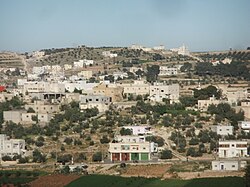Rabud
| Rabud | |
|---|---|
| Other transcription(s) | |
| • Arabic | ﺩﺍﺒﺭ |
| • Also spelled | Khirbet Rabud (official) |

Rabud
|
|
| Location of Rabud within the Palestinian territories | |
| Coordinates: 31°26′0″N 35°1′0″E / 31.43333°N 35.01667°ECoordinates: 31°26′0″N 35°1′0″E / 31.43333°N 35.01667°E | |
| Governorate | Hebron |
| Government | |
| • Type | Village council (from 1993) |
| • Head of Municipality | Muhammad Huraibat |
| Area | |
| • Jurisdiction | 2,200 dunams (2.2 km2 or 0.8 sq mi) |
| Population (2007) | |
| • Jurisdiction | 2,262 |
Rabud (Arabic: ﺩﺍﺒﺭ, also spelled Khirbet Rabud) is the site of an ancient Cannanite city and currently a Palestinian village in the southern West Bank between Israel and Jordan.
According to Palmer, the name Khirbet Rabud means "the ruin of the animal's lair".
Part of the Hebron Governorate, it is located 13 kilometers southwest of Hebron and about 5 km northwest of as-Samu. Rabud had a population of 2,262 in the 2007 census by the Palestinian Central Bureau of Statistics (PCBS). The principal families are the Huraibat, Quteinah, al-Uqela and Shanan.
According to research by the Applied Research Institute-Jerusalem, Rabud's history dates back to the Canaanite period in Palestine, but that the modern inhabitants of the village migrated from the Arabian Peninsula.
In 1863, Victor Guérin found here "caves and cisterns dug into the rock, ...small demolished houses and, on the highest point, the remains of a roughly built tower". North and south-east of this place were two pierced walls, with many caves. Guérin named them Heurkan Beni Hasan.
In 1883, the Palestine Exploration Fund's Survey of Western Palestine found here "walls, cisterns, and rude cave tombs."
The 1931 census of Palestine wrote that "the village in the Hebron sub-district commonly known as Dura is a congeries of neighbouring localities each of which has a distinctive name; and, while Dura is a remarkable example of neighbourly agglutination, the phenomenon is not infrequent in other villages". The total of 70 locations, among them Kh. Rabud, listed in the report had 1538 occupied houses and a population of 7255 Muslims.
...
Wikipedia

